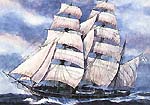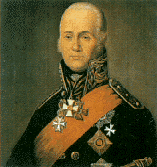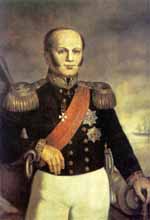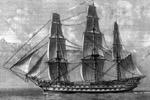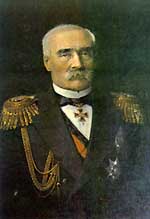| Tell a friend | Print version |
|---|
Russian Sailing Fleet in the XIXth Century: Introduction
During the military operations against the Turks, D.N. Senyavin’s troops were able to win a string of brilliant victories. Especially impressive and effective for the Russian seamen were the battles at Dardanelles and Athos. During the latter one which took place on 19 June 1807, the Turks lost one third of their ships, some 1000 men killed and wounded; more than 700 soldiers yielded themselves prisoners. What is amazing about that battle is that not a single Russian ship was lost there.
The defeat at sea was the key factor that made Turkey sign an armistice with Russia. From 1805 to 1818 Russia had been constantly involved in waging wars, mainly, on land. In the course of the Patriotic War of 1812 as well as foreign campaigns of 1813-1814, the fleet was not largely engaged. Its activity was limited to troops transportation, some operations on the sea-side flanks and blocking, together with the British, the coastline of Holland and France.
Between 1803-1813 and 1825-1827, two wars with Persia took place. The Russian troops’ actions in Eastern Caucasus were supported by the Caspian flotilla which was based in Astrakhan. The Persian troops, which invaded the territory of Taly-Shinskoye and Karabachos khanates, suffered a defeat. According to the Peace Treaty of 1828, Russia got in her possession the following territories: Erivanskoye and Nakhichevanskoye khanates as well as part of the Caspian coastline up to the Astara River. Russia was granted the right to base her war vessels in the Caspian Sea.
At the beginning of the nineteenth century, the fleet was headed by Admiral P.V. Chichagov who, unlike his father – a talented admiral V.Y. Chichagov, could not boast of keen intellect thinking the fleet was “burdensome luxury for the state”. Under his successors admirals I.I. Traverse and von Muller, the fleet fell into compete decay. Following the Turkish refusal to grant Greece its autonomy in 1827, Russia, England and France decided to conduct a joint naval demonstration nearby the Turkish shores. A squadron consisting of 4 battleships, 4 frigates, 1 corvette and 4 brigs was sent from the Baltic Sea to the Archipelago. Rear-Admiral L.P. Geiden was in command of that squadron. Having joined the British squadron of Vice-Admiral E. Condrington and the French one at the Zante Island, the ships reached the Navarino Bay. On 8 (20) October 1827, a battle against the allied Turkish-Egyptian fleet under the command of Muharrembey took place. The Russian-British-French squadron had 26 ships with 1298 guns while the Turks and Egyptians had 66 ships with 2224 guns. The Russian battleships were right in the center of the battle. It is owing to their courageous and decisive actions that the main part of the enemy fleet was destroyed. Most distinguished in the Battle of Navarino was the Azov under the command of Captain M.P. Lazarev which was the first to be awarded with the Ensign of St. George. The British and the French displayed unsurpassed naval skills and fortitude in that battle as well. In the end of that 4-hour battle the whole Turkish-Egyptian fleet was totally destroyed; 7 000 men died. The crushing defeat in the Battle of Navarino significantly weakened the Turkish naval might and military dominance; however, it did not solve the issue of Greece’s independence. The Greeks’ struggle went on.
Another Russian-Turkish war broke out in April 1828. In began with the Russian offensive operations on two directions: the Balkan Peninsula and Erzurum. The Black Sea Fleet was engaged to support the land forces in taking the enemy fortresses. As a result of the month-long siege of Anapa supported by defensive fire from the Black Sea squadron which was headed then by Vice-Admiral A.S. Greig, the fortress garrison capitulated. The same fate overtook the fortress Varna where the Russians took more than 9000 prisoners and some 300 pieces of ordnance and ammunition. In February 1829, the fortress Syzopol fell.
Advancing on the Balkans, the Russian Army took Adriapol and started to threat Constantinople. The Black Sea Fleet landed 5 landing troops on the enemy shores. Towards the end of August 1829, the Russians reached the Aegean Sea shores where the Baltic squadron under the command of Vice-Admiral L.P. Geiden had been operating. Military defeats suffered by Turkey eventually made it conclude a Peace Treaty in accordance with which Russia got the Danube estuary with all its islands as well as the Black Sea eastern shore. On top of that, Turkey confirmed Georgia, Imeretia, Mingrelia and Guria becoming constituents of Russia. Greece was granted its autonomy.
In spite of the fact that the era of steam fleet had already begun, the sailing ships construction in Russia did not stop. New sailing battleships, the prototype of which was the 84-gun ship Silistria which proved to be reliable in long voyages, were commissioned to the Black Sea Fleet.
For the first time in Russia, the 120-gun battleship the Twelve Apostles (Nikolayev) and the Russia (Petersburg) were built and commissioned. They were one of the most powerful and high-speed sailing vessels of that time.
At the outbreak of the Crimean War of 1853-1855, the Black Sea Fleet had 14 battleships, 6 frigates, 4 corvettes, 12 brigs, 7 steam-frigates built at foreign shipyards and dozens of other ships and vessels. By the beginning of the war, the Baltic Sea Fleet could boast of 29 battleships, 14 frigates, 2 corvettes, 6 brigs, 9 steam-frigates and more than 100 small sailing and oar-propelled vessels.
Despite all success achieved by Russia, our country suffered a defeat in the Crimean War. The British-French fleet, which had entered the Black Sea as the main Turkish ally, consisted, mainly, of steamships, and the Russian sailing fleet was not able to repulse the attacks of such a powerful enemy who eventually succeeded in taking Sebastopol, Yevpatoria, Kerch and Kinburn.
In that war Russia suffered insignificant territorial losses. The cities taken by the allies were returned to Russia’s possession. However, the fate of the Russian Fleet turned to be bitter. In accordance with the Peace Treaty of Paris of 18 March 1856, Russia was not allowed to have her naval bases in the Black Sea. As a result, the southern part of the country appeared to be defenseless in case of enemy attacks from the seaside (those humiliating clauses of the above-mentioned treaty were rejected by Russia as late as 1971 which was confirmed at the London Conference). Yet the fleet managed to survive.
Alexander II highly praised the Russian Fleet’s success in America, and in his rescript, ignoring the international community’ opinion, called Poland a country “which is ruled by sedition, ridden by prejudices and is under a pernicious influence of foreign instigators”. The Russia’s prestige, greatly disturbed by the Polish rebellion, was immediately enhanced. The American expedition undertaken by the Russian squadrons set a classical example of how the country’s naval might could contribute to the cause of peaceful solution of burning international issues.




